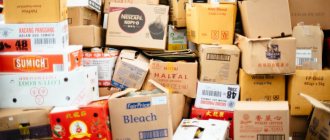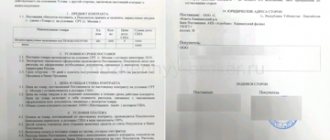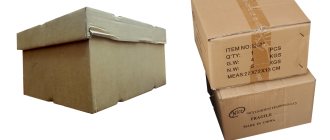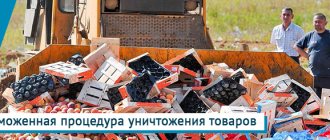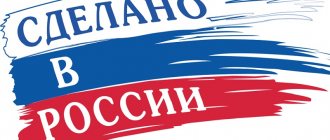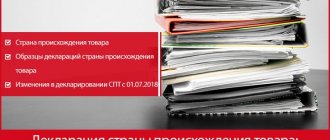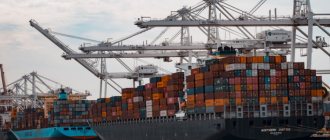Transporting goods/products for sale across state borders is a process that in most cases is associated with the application of various tariffs and fees paid to customs authorities by participants in foreign trade activities. Obviously, for market entities conducting foreign economic activity, the priority is the quick and unhindered receipt of supplies, as well as reducing the costs associated with its processing. The presence of certain types of documentation allows you to reduce costs, so it is important for organizations and entrepreneurs to pay special attention to such options. These include a certificate of the country of origin of the goods - let’s look at what it is, why and for what it is needed, and who issues such documents.
Why do you need a certificate of origin for imported goods?
This is a document that confirms the actual place of manufacture or industrial processing of cargo to be imported into the territory of the Russian Federation. The certificate allows you to calculate the customs duty rate, determining the possibility of applying preferences. Existing tariffs are conventionally divided into three categories: maximum, standard and reduced, and in cases where accompanying documentation of the type in question is not available, customs will charge an increased duty by default.
A certificate confirming the country of origin of goods, raw materials or other products allows foreign trade participants to reduce or completely eliminate the costs associated with processing cross-border transportation. In some situations, the document also exempts you from paying VAT. The circumstances that determine that the act must be provided mandatory include:
- Deliveries of goods from states with which international agreements have been concluded providing certain preferences for imports.
- Imports subject to non-tariff regulations, including those carried out within established quotas.
- Absence in the accompanying documentation of other sources indicating the place of origin of the goods.
- Customs officials have doubts regarding the reliability of the data presented in the declaration or other evidence.
- The validity of special interstate agreements defining certification as a mandatory condition for the implementation of commodity transactions.
The list of benefits provided upon presentation of properly executed documents depends on the specific country, as well as the type of product planned for import.
When registration is not required
Legal requirements are not relevant in the following situations:
- Purchase made solely for personal use.
- Application of temporary stay or transit procedures to cargo.
- Sending a heterogeneous batch, the total cost of which does not exceed 20 thousand rubles.
It is worth noting that in a number of foreign countries, imports worth less than $5,000 allow the usual accompanying documentation to be presented as part of the inspection, which serves as an alternative to SPT.
General overview
The specified document regulating the issue under consideration was signed in Yalta in 2009, and includes a number of specific rules that should be taken into account when registering transactions and financial transactions. Based on the content, each state that has ratified the agreements reached and in whose territory the product was produced or underwent significant processing in accordance with established legal standards is the country of origin of the product.
It is important to take into account that there is a difference between this concept and the wording characterizing the name of the place of receipt of products - in accordance with the Civil Code (Article 1516), in the second case a specific territorial location is meant, which is strongly associated with the unique features of production. As an example - Vologda butter, Tula gingerbread, etc. In addition, there is a difference from such a term as the location of the manufacturer. Thus, if one of the market participants plans to submit an application for a state or municipal tender, the indication of the manufacturer, and not the country of origin of the goods according to the classifier and register of names, as prescribed by 44-FZ, is the basis for the customer to make a negative decision - due to inconsistency of the documentation.
It is also worth noting that the state in which the trademark is officially registered and the actual place where the product is manufactured are not always the same region. Today, it is a common practice in which large corporations, licensed in the USA or Germany, organize manufactories in the territories of third world subjects, thereby significantly reducing labor costs and tax costs.
Ready-made solutions for all areas
Stores
Mobility, accuracy and speed of counting goods on the sales floor and in the warehouse will allow you not to lose days of sales during inventory and when receiving goods.
To learn more
Warehouses
Speed up your warehouse employees' work with mobile automation. Eliminate errors in receiving, shipping, inventory and movement of goods forever.
To learn more
Marking
Mandatory labeling of goods is an opportunity for each organization to 100% exclude the acceptance of counterfeit goods into its warehouse and track the supply chain from the manufacturer.
To learn more
E-commerce
Speed, accuracy of acceptance and shipment of goods in the warehouse is the cornerstone in the E-commerce business. Start using modern, more efficient mobile tools.
To learn more
Institutions
Increase the accuracy of accounting for the organization’s property, the level of control over the safety and movement of each item. Mobile accounting will reduce the likelihood of theft and natural losses.
To learn more
Production
Increase the efficiency of your manufacturing enterprise by introducing mobile automation for inventory accounting.
To learn more
RFID
The first ready-made solution in Russia for tracking goods using RFID tags at each stage of the supply chain.
To learn more
EGAIS
Eliminate errors in comparing and reading excise duty stamps for alcoholic beverages using mobile accounting tools.
To learn more
Certification for partners
Obtaining certified Cleverence partner status will allow your company to reach a new level of problem solving at your clients’ enterprises.
To learn more
Inventory
Use modern mobile tools to carry out product inventory. Increase the speed and accuracy of your business process.
To learn more
Mobile automation
Use modern mobile tools to account for goods and fixed assets in your enterprise. Completely abandon accounting “on paper”.
Learn more Show all automation solutions
Types of certificates of origin of goods
The key factor determining the type of documents drawn up is the place of manufacture of the product. The following forms are distinguished:
- General - issued as part of cargo export to the territory of countries that do not require other certification acts. It does not provide preferences, acting as a basis for going through standard customs procedures. Filled out in Russian and English format.
- “A” - documentation filled out exclusively in English, the registration of which is mandatory when exporting products from the Russian Federation to Montenegro.
- “ST-1” is valid on the territory of the CIS countries and is considered the basis for providing preferential conditions for further circulation. Drawed up in Russian, valid for one year from the date of issue. Not required for transactions carried out with counterparties from Belarus or Kazakhstan, which is determined by special regulations of the Customs Union.
- “ST-2” is a certificate confirming the country of origin of goods, adopted between Russia and Serbia since 2000.
- “EAV” - from 2021 is mandatory when preparing export deliveries to Vietnam.
It is also worth noting that the shipment of steel, textiles or furs (as well as products made from them) into the EU requires filling out the SPT at customs in the official language of the state into which import is planned.
How to confirm if admission conditions are set
The Ministry of Finance determined the list of imported goods that are subject to purchase and established the conditions for admission by Order of the Ministry of Finance No. 126n dated 06/04/2018. To conclude a contract at the price specified in the proposal, indicate in the application information that the product was manufactured in the territory of the EAEU.
The Ministry of Finance in Letter No. 24-01-07/2281 dated January 18, 2019 explained that when purchasing products for which admission conditions have been established, the supplier only needs to indicate the country of origin in the application. Preparation of a declaration is not mandatory, but there are suppliers who attach this document in the second parts.
Excerpt from the letter from the Ministry of Finance:
Use the declaration if this document is part of the application under the terms of purchase. For example, this is practiced in procurement under 223-FZ.
What is needed for registration
To undergo certification, you will need to collect documentation, the list of which remains virtually unchanged regardless of the required form. The package includes:
- Statement from the sender.
- Transaction documents reflecting terms and costs.
- Letter from the manufacturer, including cases where foreign raw materials were not purchased or used as part of the manufacturing cycle.
- A packing list containing the register and characteristics of the product.
- Waybills or bill of lading - if the shipment is sent by an intermediary.
- Details of the organization acting as the exporter, as well as constituent documentation.
- An act confirming the passage of an examination that determines the actual place of origin, or other certificates, licenses and certificates, the type of which is determined based on the type of product.
In the absence of time, experience and qualifications to quickly prepare everything necessary for customs clearance, you can resort to the help of professional representatives. However, when international deliveries are planned on a regular basis, a more practical solution is to hire a permanent employee responsible for the implementation of specific processes related to foreign trade activities.
Differences from similar terms
The complexities of terminology at the initial stages can confuse entrepreneurs who are not familiar with the specifics of defining a specific territorial entity. There are several similar concepts that require market participants to be especially careful when preparing documentation:
- Designation of origin of products. In this case, we are talking about regions associated with unique products, be it the previously mentioned Tula gingerbread, or another stable combination.
- Manufacturer's location. Despite the apparent identity, the value is not identical to the country of production, which is due to the possible difference between the registration data and the actual location of production facilities.
In addition, it is important to take into account that the provisions enshrined within the framework of Article 33 of Federal Law-44 determine the list of requirements in accordance with which documentation must be drawn up. Such rules, in particular, indicate that the description of an object appearing as the subject of a tender should not contain references indicating trademarks, the name of the place of origin or the manufacturer.
Where and how is certification carried out?
In accordance with legislative norms, the right to issue is vested in the Chamber of Commerce and Industry of the Russian Federation, its regional representative offices, as well as special licensed and accredited bodies. The procedure includes several stages:
- Selecting a suitable territorial department.
- Analysis of requirements and collection of documentation.
- Drawing up an agreement with an expert organization - if it is necessary to provide a certificate that is a certificate of origin of the goods.
- Submitting an application and receiving a certificate.
The procedure for circulation of documents involves the use of special printing forms for printing, on which security elements are applied to prevent forgery. Information about the issue is entered into the official register.
All-Russian classifier
Resolution No. 529, approved by the State Standard of the Russian Federation, became the basis for the creation of a general register, which today is not difficult to find in open sources. Its use is important from the point of view of preventing possible errors made when writing letter and number codes. In accordance with OKSM, each region of origin of the goods - Russia, China, the USA, as well as the countries of the European Union - Italy, Germany, etc. — the directory assigns a digital code and a specific name, the correctness of which is strictly controlled when checking the completion of the relevant fields of the declaration or accompanying documents.
How to fill out an application correctly
The Regulations do not establish strict requirements, allowing applications to be filled out in any format. The details that must be provided by the applicant include:
- Address and name of the certification body, as well as the manager.
- Data of the organization or individual entrepreneur, or an authorized representative.
- A variety of the required form, with a list of nomenclature codes.
- List of accompanying documents.
- Date of compilation and signature.
The application is drawn up in two copies. The first is transferred to the accredited body, the second remains in hand - with a mandatory mark of receipt, which is the basis for counting the time period allotted for issuance.
Features of working with the electronic platform
A government decree published in February 2020 under No. 180 determines that bidders applying for a competition or auction, or submitting proposals, are required to select the attribute in question using the item qualifier when filling out the standard form. The official directory also contains a digital code of the country of origin of the goods (Russia - 643) for issuing a customs declaration, UPD, invoice, as well as other permits and accompanying documents. The technical specifications contain data for each item planned for delivery, use within the production process or provision of services. The responsibility of the customer, in turn, comes down to putting forward a requirement to provide the specified information, and their subsequent verification for compliance with legal standards.
Terms and cost of registration
The duration of processing the application and preparing the permitting act depends on the efficiency of the selected institution. The best option is to provide a certificate of the country of origin of the goods in a general form within one day, but the maximum period can be up to ten working days. The costs associated with completing the procedure are determined by the requirements for the accompanying documentation - the greater the number of certificates and acts that need to be collected, the higher the final costs will be, varying in the range from 5 to 20 thousand rubles.
National treatment under Law No. 44-FZ: practice of application
Many questions arise regarding the application of national treatment in accordance with Law No. 44-FZ in practice. This article will address a number of questions, for example, where to get the CT-1 certificate?
Regarding the application of national treatment in accordance with Law No. 44-FZ, many questions arise in practice, for example: how to confirm the Russian origin of certain goods? Where can I get a certificate of form ST-1? What to do if the application contains Russian and foreign goods?
How to find out that national treatment applies to public procurement?
If a national regime applies to any product, then the state customer must indicate the requirement in the schedule and reflect in the procurement documents:
- reference to the government decree on the basis of which the national regime operates;
- a condition regarding the fact that in the application the participant indicates the unit price for each item, and the participant is responsible for providing false information about the country where the goods were produced;
- What documents can the participant use to confirm that the place of origin of the goods is one of the EAEU countries?
What documents can confirm the country of origin of a product?
Which document must be attached to the application is determined by the type of product. It could be:
- certificate of examination of the Chamber of Commerce and Industry (its validity period is one year);
- declaration of country of origin (in free form);
- certificate in form ST-1, which is issued on the basis of an examination report or at the request of the supplier: annual (for medicines), three months or one-time;
- SPIC, or a copy of a special investment contract (if a legal entity invests more than 3 billion rubles in the production of a product in Russia, and the state purchases it without holding a competition).
When purchasing a number of goods, the Government of the Russian Federation indicates with which documents the procurement participant has the right to confirm the country of origin.
For example, when purchasing radio-electronic products:
- confirmation from the Ministry of Industry and Trade of the Russian Federation about the production of these goods on Russian territory;
- SPIC;
- a notification from the Ministry of Industry and Trade of the Russian Federation confirming the status of telecommunications equipment manufactured in Russia;
- annual or one-time certificate in the form ST-1.
When purchasing mechanical engineering goods or furniture:
- certificate of examination of the Chamber of Commerce and Industry;
- SPIC;
- certificate in form ST-1.
When purchasing medical devices for which there are access restrictions, a certificate in the ST-1 form.
When purchasing products - a declaration of the country where the product was produced (in free form), as well as the country of its origin.
When purchasing light industry goods - a declaration of the country of origin of the goods, as well as materials and semi-finished products that were used to produce commercial products.
When purchasing software - the name of the software, as well as a declaration of its country of origin (in free form).
If during procurement there is no mandatory requirement to provide a certificate in the ST-1 form, then the participant independently determines the form that is confirmation of the country of production. This may be a certificate in the ST-1 form, a declaration, or another of the above documents.
The seller and manufacturer of the product can independently draw up a free-form declaration about the country of origin of the product (Order of the Ministry of Economic Development of the Russian Federation No. 155 of March 25, 2014). For example, it is possible to attach a table with the country of origin and goods for each item to the application.
The name of the country of origin must be indicated in full accordance with the classifier of countries of the world (for example, it does not include the country of the USA - there is the United States of America). Because of such a seemingly harmless reduction, the customer may reject your application, and he will be right. For example, this is indicated in the Resolution of the Arbitration Court of the Central District dated September 12, 2017 No. F10-3317/2017 in case No. A54-7222/2016.
What can happen if supporting documents are not attached to the application?
If there is a ban on the purchase of foreign goods, an application without supporting documents will be rejected (for example, if you are supplying light industrial goods or furniture).
If there is no ban on the supply of foreign goods, but there is a price preference for Russian goods, the application will be considered as foreign. That is, when holding an auction, it will be necessary to conclude a government contract with a price that is 15 percent less than the proposed one; in other competitive procurements, when evaluating the application, the participant will not receive a reducing factor to his price.
If there is a “third man out” rule when conducting a procurement, then the participant’s application will be considered as an application with a foreign-made product. If at least two participants came to the government procurement and confirmed the Russian origin of the goods, then the application will be rejected.
The certificate in form ST-1 and the declaration contain different data: what will happen?
In the first part of the application for participation in the electronic auction, the supplier must declare the country of origin, in the second, a certificate in the form ST-1 (if required) must be attached.
When considering an application for an auction, the customer must compare the documents in its two parts: in the first part - the country of origin, in the second - the certificate in the ST-1 form. The discrepancy in the data indicates that the winner provided inaccurate information. In this case, the application will be rejected as not meeting the procurement requirements.
How does the customer check the origin of the goods?
If it is enough to declare the country of origin of the goods in the application, the government customer takes the winner at his word: he specifies the specified country of origin in the contract, and checks the documents only upon acceptance of the goods. If a purchase requires a certificate in the ST-1 form, customers can independently verify that it is genuine. The fact that the certificate was issued can be checked in the register (on the Chamber of Commerce and Industry website).
Is it possible to declare Russian goods while delivering Chinese goods?
If the national regime was in effect during the procurement, then the product cannot be replaced, even if it has improved characteristics. The customer is obliged to refuse such goods. The winner will have to terminate the contract or supply goods of Russian origin.
The customer can meet halfway, but only by mutual agreement
If the customer terminates the government contract in court or unilaterally on the basis of the supplier providing false information regarding the compliance of its product with the established requirements, it will become the winner of the auction. In this case, the supplier faces the loss of contract security and inclusion in the RNP.
Certificate in form ST-1: how to get it?
The document can be issued at the regional Chamber of Commerce and Industry (the basis is an examination certificate completed by employees of the same chamber). This act is valid for one year after its issue. To obtain a certificate, the bidder must write an application to the Chamber of Commerce and Industry, attaching to it:
- documents of title (for individuals - passport, for legal entities - certificate of registration, as well as registration);
- annual examination certificate (if available).
If there is no act, then to obtain ST-1 you need to submit:
- licenses for the production of goods;
- information confirming the ability to produce the goods (the Chamber of Commerce and Industry should clarify what information to provide).
In the application, part of the goods is foreign, and part is Russian: what will happen?
If there is a ban on the purchase of foreign goods, then applications with fully or partially foreign products will be rejected. If certain price preferences apply, the customer’s actions will depend on the cost of goods from the EAEU specified in the application.
At auction
If the cost of a product originating from the EAEU is more than 50 percent of the bid price, then the supplier has the right to receive preferences, and if it wins, its price will not be reduced by 15 percent. If the value of goods from states that are members of the EAEU indicated in the application of the winner of the auction is less than 50 percent of the cost of other goods, then if they win, the total price of the government contract will be reduced by 15 percent.
When conducting other competitive procurements
If in a request for proposals, quotation or competition a participant offers more than 50 percent of products from the EAEU in his application, he will receive preferences, and a reduction factor will be applied to the price of his application.
Note that it is not the volume of the product that matters, but its price. For example, 51 percent of the application volume is foreign-produced salt, 49 percent is sugar from the EAEU countries. But since sugar is more expensive, the price of the Russian product in the application will be more than 50 percent of the price of the entire purchase volume, and the supplier will receive preferences. For this reason, the government customer in procurements with a national regime will ask to indicate the origin, as well as the cost for each item of goods.
The purchased goods are not produced in the EAEU countries: what to do?
If the purchased goods are not produced in the EAEU countries, then the customer can purchase foreign goods. The only document proving the absence of Russian analogues is the corresponding conclusion of the Ministry of Industry and Trade of the Russian Federation. Other evidence will be ignored by the customer, and the application with foreign goods will be rejected.
Tags : national regime,
January 30, 2018
Number of views: 9239
Please rate how useful this material was.
Rating: 5/5 — 3 votes
Similar articles:
- Regulations have been approved for checking delivered goods using both video and photographic equipment for compliance with the information under the contract (185)
- The requirement for a minimum price and contract period for assessing experience in public procurement is illegal (164)
- FAS Russia clarified issues regarding the inclusion of information in the Register of Unscrupulous Suppliers (157)
Comments ()
- Mikhail Vasilievich Ivanov October 16, 2021, 16:02 0
Due to inattention, they wrote the country of origin of the goods (crushed stone fr. 2-5 mm for sprinkling roads) Russia and the goods were delivered from the Republic of Belarus. Despite the fact that in this auction, Law 126 of the Ministry of Finance was established, clause 1.7 of which allows changing the country of origin of goods if it is part of the EAEU, and the customer did not indicate the country of origin of the goods in the contract, thereby violating the decree dated 27.12. 2021 No. 449-FZ on amendments to the Federal Law on the Contract System, indicating the obligation of the customer to indicate in the contract the country of origin of the goods, the Federal Antimonopoly Service for Moscow nevertheless included us in the RNP. And earlier we received a letter from the FAS Russia, which stated that it is not a violation of 44-FZ if the country of origin of the goods. specified in the first part of the application did not have preferences over the country whose goods were supplied during the execution of the contract. And since both countries are members of the EAEU, according to the Federal Antimonopoly Service of Russia law dated November 22, 2019, there are no preferences between Russia and Belarus in this case. Therefore, we considered this to be our case!!! Hence, we do not understand why we were included in the RNP, despite the fact that the two above laws, as we believe, are on our side, especially since the customer also grossly violated 44-FZ and this crushed stone, we believe, does not even need certification . What is this - double standards!!!answer
Write a comment
Ready-made solutions for all areas
Stores
Mobility, accuracy and speed of counting goods on the sales floor and in the warehouse will allow you not to lose days of sales during inventory and when receiving goods.
To learn more
Warehouses
Speed up your warehouse employees' work with mobile automation. Eliminate errors in receiving, shipping, inventory and movement of goods forever.
To learn more
Marking
Mandatory labeling of goods is an opportunity for each organization to 100% exclude the acceptance of counterfeit goods into its warehouse and track the supply chain from the manufacturer.
To learn more
E-commerce
Speed, accuracy of acceptance and shipment of goods in the warehouse is the cornerstone in the E-commerce business. Start using modern, more efficient mobile tools.
To learn more
Institutions
Increase the accuracy of accounting for the organization’s property, the level of control over the safety and movement of each item. Mobile accounting will reduce the likelihood of theft and natural losses.
To learn more
Production
Increase the efficiency of your manufacturing enterprise by introducing mobile automation for inventory accounting.
To learn more
RFID
The first ready-made solution in Russia for tracking goods using RFID tags at each stage of the supply chain.
To learn more
EGAIS
Eliminate errors in comparing and reading excise duty stamps for alcoholic beverages using mobile accounting tools.
To learn more
Certification for partners
Obtaining certified Cleverence partner status will allow your company to reach a new level of problem solving at your clients’ enterprises.
To learn more
Inventory
Use modern mobile tools to carry out product inventory. Increase the speed and accuracy of your business process.
To learn more
Mobile automation
Use modern mobile tools to account for goods and fixed assets in your enterprise. Completely abandon accounting “on paper”.
Learn more Show all automation solutions
Responsibility for violations
Situations where exporters deliberately seek to circumvent existing restrictions by resorting to falsification of acts are quite rare. This is primarily due to the severity of the penalties provided for by the Administrative and Criminal Codes of the Russian Federation for such actions. However, the basis for collecting fines are also technical errors made during the registration process - the general list is detailed in the contents of the sixteenth chapter of the Code of Administrative Offenses.
Certificate ST-1
Crossing the territorial borders of CIS countries with products, as well as participation in procurement organized on a competitive basis, determines the supplier’s obligation to provide a certificate of origin of the goods corresponding to the specified form. The document must be drawn up on a special form with security features and comply with the standard established by regulations and international agreements. Contents include:
- Information about the sender and recipient of the cargo (importer and exporter).
- Information about the vehicle and logistics plan.
- Certificate number and name of the state that issued the certificate.
- Purpose of registration and duration of action.
- Serial numbers by position, number of pieces and type of packaging.
- Quantity, description and characteristics of products.
- Criteria determining origin.
- Invoice details.
- Certification certificate.
- Declaration of the applicant.
In situations when it comes to participation in government procurement, the duration of the action depends both on the number of tenders for which applications are submitted and on the specifics of the product. For one auction, the period is determined equal to its duration; in the case of several, it is set with a limit of three months, and if the object of the transaction is medicines, it is extended for a year.
Features of establishing priority for Russian-made goods
Law No. 223-FZ determines priority for Russian-made goods. Decree of the Government of the Russian Federation dated September 16, 2016 No. 925 defines the specific benefits for Russian goods. The offer with the best price wins. The proposal for the supply of Russian-made goods according to cost criteria is evaluated at the contract price proposed in the application, with a deduction of 15%. In this case, the contract is concluded at the price specified by the participant in the application for participation in the procurement.
If the auction winner submits an application with an offer to supply foreign-made goods, a contract with him is concluded at a price 15% less than that indicated in the application.
If the contract price is reduced by the auction winner to zero, then the contract will be concluded at a price increased by 15% of the contract price offered by him. The application of these mechanisms depends on which tendering method is specified in the procurement regulations.
Replacing a joint venture is appropriate when Russian-made goods are supplied as a replacement, but their quality, functional and technical characteristics fully comply with those specified in the contract. However, there is no condition for the supply of absolutely identical Russian-made goods.
Production from components or materials produced by a foreign enterprise is allowed. If the main condition of sufficient processing or processing is met (i.e. the classification code of the product is changed in the Unified Commodity Nomenclature for Foreign Economic Activity at least at the level of the first four characters), the joint venture may be Russia. Other conditions are exceptions to the basic rule.
Conditions for sufficient processing:
- Change in the classification code of goods of the first four characters.
- Conditions, manufacturing operations or technological processes have been sufficiently fulfilled to qualify as the country of origin where the operations were carried out.
- Change in cost. The percentage of the cost of materials or components or added value reaches a fixed share in the final price.
What is required to receive
The law determines which countries require the ST-1 form and grants the right to issue certificates of this category to the Chamber of Commerce and Industry of the Russian Federation, which provides this service on a paid basis. The official website of the department provides a list of regional divisions to which you can contact and submit the appropriate application. Both manufacturers and suppliers act as applicants - it is enough to fill out the appropriate application and collect a package of documents, including:
- Constituent documentation of the enterprise.
- Passports and quality certificates, as well as technical instructions.
- Register by position, indicating components and country of origin.
- TTN and invoices.
- Distributors - a letter of guarantee certifying the purchase obligation.
The period allotted for registration is five working days. During this period, employees of the selected department must conduct an examination to determine the product’s compliance with the stated requirements. The primary act is the basis for making the final decision on certification.
A negative verdict on an application is possible if the following factors are present:
- Some required documentation is missing.
- The state duty has not been paid.
- A discrepancy between the declared and actual place of manufacture was revealed.
In case of a positive outcome, copies of documents confirming the issuance of the certificate are entered into the register of the Chamber of Commerce and Industry and are stored for at least three years. Access is open - any interested party can view the information using a special service. To search for information, it is enough to indicate the details and the date of compilation.
Consequences of data mismatch between invoice and certificate
The supplier is responsible if differences are noted between the invoice and the certificate of conformity.
If inaccuracies are identified during the application stage, the application will be deemed ineligible as documents and information were not provided.
If inconsistencies are detected at the stage of concluding a contract, the principle of “minus 15%” to the assigned price will be adopted.
If a discrepancy is recorded at the stage of contract execution, the customer has the right to unilaterally refuse to perform the contract due to the lack of reliable information. It is possible to consider inclusion in the register of unscrupulous suppliers (URS).
If the joint venture is indicated incorrectly on the invoice, VAT deduction may be denied. This can be challenged - the chances of winning are high.
If the invoice does not indicate or incorrectly indicates the name of the country or its code, or there is an error in the customs declaration number, these inaccuracies are considered a minor error, so there will be no obstacle to deducting VAT.
Discrepancy between data and form ST-1
If the declaration and certification information differ, the customer side is obliged to initiate termination of the contract with the winning bidder. The procedure is carried out voluntarily or through the courts, while the second option entails a deterioration of reputation and inclusion in a separate register containing data on unscrupulous suppliers.
Determination rules
It is necessary to understand and distinguish between the following product categories:
- The location of its manufacturer.
- The name of its place of origin.
- Country name of the trademark.
Let's show the difference with an example.
The owner of the iPhone trademark is Apple Corporation, which is registered in the state of California, and its subsidiaries are scattered throughout the world (for example, for Europe - in Ireland). At the same time, the iPhone is assembled in China, in the province of Guangzhou.
Thus, for the European market these will be:
- USA, California.
- People's Republic of China, Guangzhou province.
- Ireland.
There is also the concept of “localization” - this is when the “frame” (for example, of a car) is assembled in one state (for example, BMW sends components from Poland to Kaluga in partial assembly, and complete assembly takes place in St. Petersburg or Moscow), and the final assembly takes place in another. In this case the situation is as follows:
- Republic of Poland.
- Russian Federation.
- Germany.
Rejection of the application
An absolute ban on the import of certain categories makes participation in the auction futile. The presence of a rule on price preference determines the need for correlation with the shares of Russian products. Admission restrictions dictate the application of the “third wheel” rule. Submitting two requests from different manufacturers, which present products manufactured in Russia or the EAEU countries, in the presence of the ST-1 form, is grounds for rejecting the remaining applicants.
Thus, the answer to the question of whether a certificate of origin of goods is required in the Russian Federation or not depends on the specifics of a particular foreign trade operation.
The registration procedure itself is not particularly complicated, but it requires knowledge of the specifics and legal nuances, as well as the availability of a sufficient amount of free time. Automation of routine accounting processes helps to highlight it and reduce everyday costs - the solutions offered provide comfortable conditions that allow you to focus on priority business tasks. Number of impressions: 1309
What to do if the product does not meet the declared quality
When delivering goods, the quantity, expiration date (if available), availability of certificates and instructions are subject to verification. But the quality characteristics are checked only by an external expert. Those. Comments regarding, for example, uneven housing will not be accepted, since this relates to quality characteristics.
If the customer is not satisfied with the quality and intends to refuse to accept the goods, he retains the right to assemble an expert commission on his own, but only if the contract was concluded as a result of a competitive procurement or with a single supplier, or the goods underwent a mandatory examination. In other cases, it is necessary to hire an expert.
From judicial practice: the supplier has the right to insist on the continuation of the contract if differences with the declared characteristics have been identified in one or more units. If the customer refuses the contract, the dispute is resolved in court.
